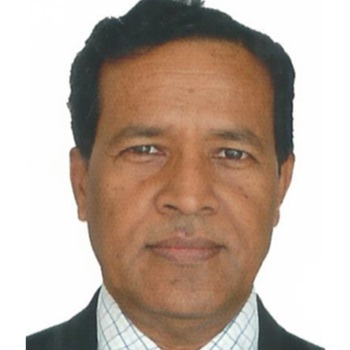.png)

Barendra Kumar Bhoi is currently the Chief Economic Adviser, AU Small Finance Bank. He was formerly the head of the Monetary Policy Department at the RBI.

Dr Hemachandra Padhan is an Assistant Professor, General Management and Economics, IIM Sambalpur.*
August 22, 2025 at 5:44 AM IST
India aspires to become a developed economy by 2047, with a GDP of $30 trillion and a per-capita income of $18,000-$20,000, as per NITI Aayog’s projections. India is currently the fifth-largest economy in the world, with a GDP of $3.9 trillion in the financial year 2024-25. India is expected to surpass Japan and become the fourth-largest economy by the end of the current financial year and the third-largest by 2027-28 by overtaking Germany.
A debate has started over whether the Indian economy can sustain high growth momentum over the next 23 years or slip into the middle-income trap, like many other emerging market economies.
Scenario Analysis
Given the strong macroeconomic fundamentals of the economy, India can grow at least at 6-6.5% in the worst-case scenarios amidst geopolitical risks, tariff wars, disruptions in global supply chains and uncertain capital flows. Some improvements in these global headwinds may propel India’s growth to its potential level of 7-7.5%. If the GDP deflator remains within 4%, the nominal GDP growth may range from 10 to 11.5%.
Based on these perceptions, a scenario analysis has been conducted to chart India’s growth prospects up to 2047-48.
Assuming an average annual depreciation of the dollar/rupee rate by 3%, India’s GDP is likely to exceed $24 trillion by 2047-48 in the best-case scenario (real/nominal GDP growing at an average rate of 7.5%/11.5%). The projection is promising, but inadequate to reach $30 trillion unless India’s GDP grows above 8.5% (or 12.5% in nominal terms) on average and/or the rupee depreciates by less than 3% annually.
As India is the most populous country in the world and likely to remain so for the next two to three decades, raising India’s per-capita GDP in dollar terms would be a daunting task. India’s per-capita GDP was $2,700 in 2024-25, much lower than other EMEs such as China ($13,700), Indonesia ($5,400), and Vietnam ($4,700).
According to the World Bank classification, India is still in the lower-middle-income group. India’s per-capita GDP may be around $14,500 by 2047-48, which is close to the bare minimum required to be considered as a developed economy as of now. The minimum per-capita GDP requirement for a developed economy by 2047 might be well above the current level, which India is unlikely to achieve.
Middle-Income Trap
Currently, there are more than 100 middle-income countries in the world whose per capita income ranges from $1,136 to $13,845. Can they become developed countries in the next two to three decades?
Many emerging market economies face the risk of falling into the middle-income trap once they reach a per-capita income of around $10,000. Transition to the high-income group becomes difficult as their GDP growth slows down. This can be attributed to multiple reasons, such as productivity slowdown, over-dependence on low-end manufacturing, rising labour costs, governance and infrastructure bottlenecks, inadequate innovations due to low R&D expenses, and a high base.
East Asian tigers, South Korea, Singapore, and Taiwan, escaped the middle-income trap mainly due to strong institutions, suitable industrial policies, high R&D spending, investment in education, improvement in labour productivity, and integration into global value chains. However, Malaysia, Brazil, Chile, and South Africa are stuck in a trap owing to inadequate innovations, productivity slowdown, and structural problems.
Opportunities for India
India is likely to maintain its status as the fastest-growing major economy in the world for a longer period, as its growth is largely home-grown, mainly financed by domestic savings to the extent of over 97%, with foreign savings supplementing only marginally, to the extent of less than 3%.
India’s gross fixed capital formation is around 30% of GDP (at current prices), which is unlikely to grow much in future. Hence, India’s growth will be consumption-driven, supported by an improvement in productivity. India may graduate from an investment-driven to a consumption-driven economy in the 21st century, with its investment-GDP ratio remaining, by and large, stable at the current level.
To improve productivity, the government has already implemented several big-bang structural reforms in recent years. Important among them are the introduction of GST, digitisation of the economy, revolution in the payment and settlement systems, ease of doing business, flexible inflation targeting, changing energy mix (transition from fossil fuel to renewable sources), building infrastructure (both physical and digital), industrial reforms, including ‘Make in India’, ‘Start-up India’, Production-Linked Incentive schemes, financial sector reforms such as asset quality review, restructuring of NBFCs, and introduction of a robust resolution mechanism (Insolvency and Bankruptcy Code), etc.
Several structural reforms, including the National Education Policy, ease of doing business, internationalisation of the rupee, and fiscal reforms, are being implemented on an ongoing basis. Moreover, consistent macroeconomic policies, financial stability, technology adoption, and demographic dividend are expected to drive India’s future growth.
Challenges Ahead
Many East Asian countries, such as Japan, South Korea, Singapore, and Taiwan, witnessed real GDP growth of 10% or more for decades before becoming developed countries. The climate risks were not a binding constraint to growth for these countries.
In the 21st century, double-digit growth has become virtually impossible due to anti-globalisation policies being pursued by many countries. Moreover, a major speed-breaker of growth in the current century so far has been more frequent global financial instability, which creates uncertainties through disrupting value chains and capital flows.
Middle-income countries face the global headwinds in stride and adjust according to their capabilities. India’s strategy has been broadly Aatmanirbhar Bharat in the fast-changing global economy.
India-specific major macroeconomic problems are mainly two: inequality and unemployment. For inclusive growth, the government has been implementing several welfare programmes targeted at the marginalised section of society.
Certain direct benefit transfer schemes are freebies, which create perverse incentives for beneficiaries to substitute leisure for work. This increases labour costs and militates against GDP growth. It is better to have a comprehensive social security system for the country as a whole rather than introduce multiple welfare schemes on an ad hoc basis at different points in time.
Unemployment is a major challenge in the 21st century. Technology is replacing labour in a big way around the world. A market economy cannot afford to ignore modern technology as it improves productivity. Reskilling labour takes time. In the process, the share of wages in GDP has declined in many countries, including India. This is also contributing to income inequality. Employment generation through incentive schemes is a temporary solution, which may not be sufficient to absorb the growing workforce. The NEP needs to transform India’s education system quickly and provide quality education to improve labour productivity.
The services sector alone cannot provide adequate employment to the growing workforce. India’s manufacturing sector has to revamp quickly. Its share in GDP has been shrinking over the years. Low-end manufacturing by MSMEs is unlikely to make India a manufacturing hub of the world. India needs to follow a balanced approach to promote both MSMEs and large manufacturing industries. This can provide gainful employment to the growing workforce.
The top three priorities for the government are to: a) pursue next-generation reforms, particularly in product and factor markets; b) address pressing macroeconomic problems to reap the demographic dividend, and c) strengthen infrastructure, particularly in rural areas, to reduce the rural-urban divide. India has a fair chance to escape the middle-income trap.
* Views are personal.




